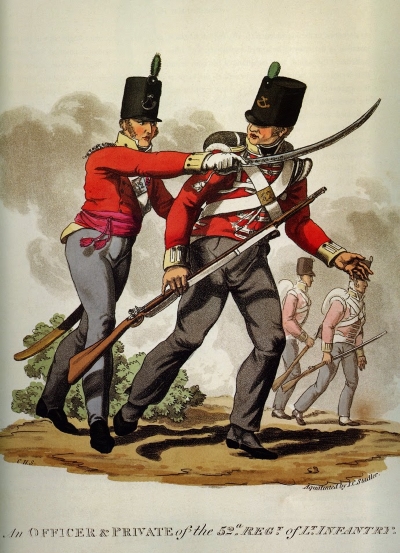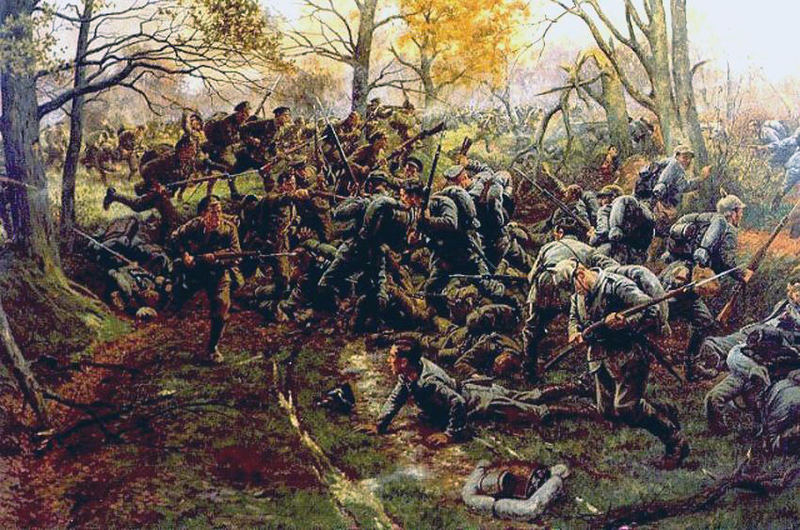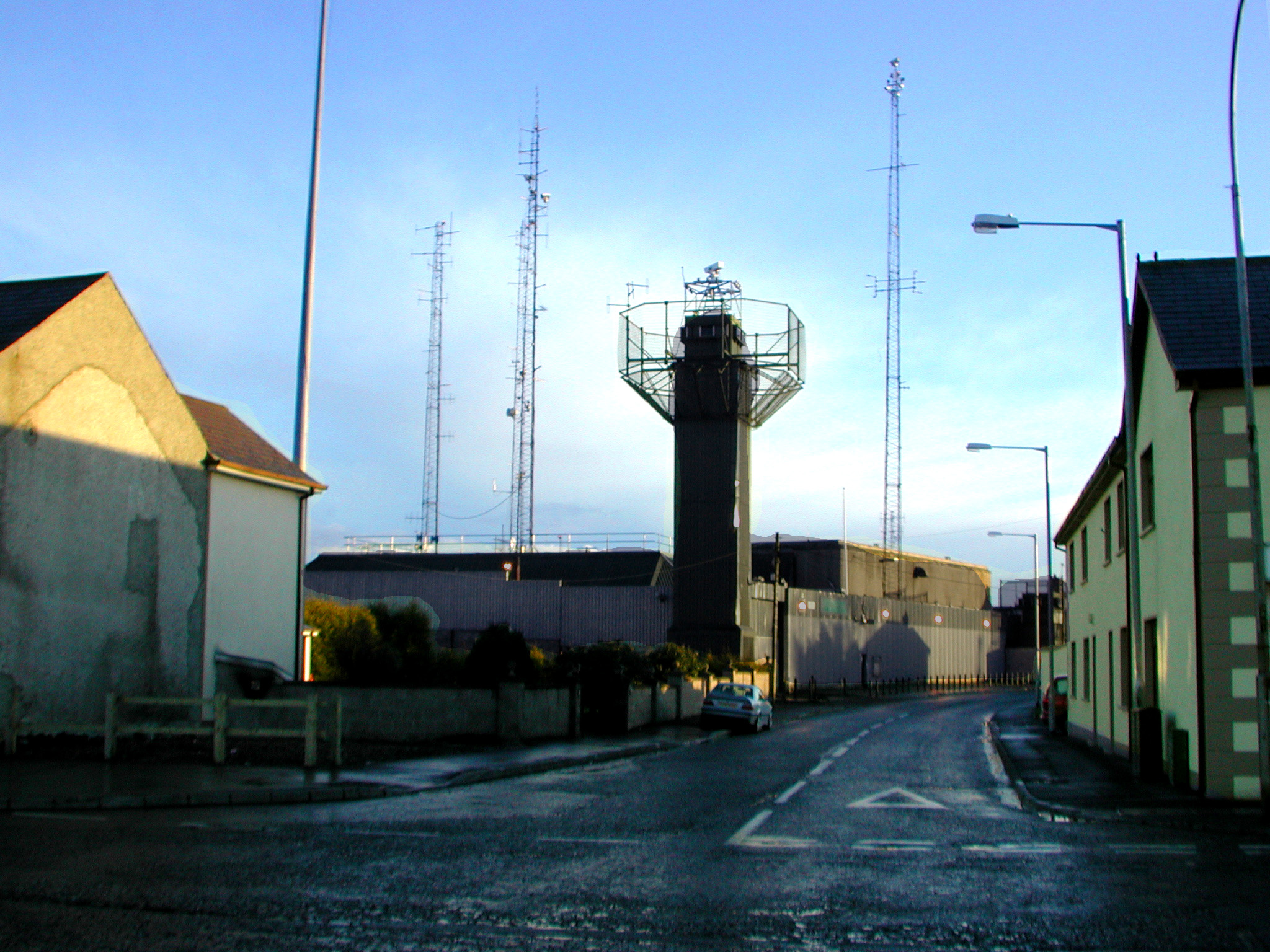|
RGJ
The Royal Green Jackets (RGJ) was an infantry regiment of the British Army, one of two "large regiments" within the Light Division (the other being The Light Infantry). History The Royal Green Jackets was formed on 1 January 1966 by the amalgamation of the three separate regiments of the Green Jackets Brigade: *1st Green Jackets (43rd and 52nd) *2nd Green Jackets, the King's Royal Rifle Corps *3rd Green Jackets, the Rifle Brigade (Prince Consort's Own). There were also two Territorial Army battalions made up as follows: * 4th (V) Battalion, Royal Green Jackets – formed from the remnants of the Rangers (KRRC), London Rifle Brigade, Tower Hamlets Rifles, Queen's Westminsters, Queen Victoria's Rifles, Queen's Royal Rifles and Civil Service Rifles. * 5th (V) Battalion, Royal Green Jackets – formed from the 4th Battalion, Oxfordshire and Buckinghamshire Light Infantry (TA) and the Buckinghamshire Battalion, Oxfordshire and Buckinghamshire Light Infantry. During the 1980s, the ... [...More Info...] [...Related Items...] OR: [Wikipedia] [Google] [Baidu] |
King's Royal Rifle Corps
The King's Royal Rifle Corps was an infantry rifle regiment of the British Army that was originally raised in British North America as the Royal American Regiment during the phase of the Seven Years' War in North America known in the United States as 'The French and Indian War.' Subsequently numbered the 60th Regiment of Foot, the regiment served for more than 200 years throughout the British Empire. In 1958, the regiment joined the Oxfordshire and Buckinghamshire Light Infantry and the Rifle Brigade in the Green Jackets Brigade and in 1966 the three regiments were formally amalgamated to become the Royal Green Jackets. The KRRC became the 2nd Battalion, Royal Green Jackets. On the disbandment of the 1st Battalion, Royal Green Jackets in 1992, the RGJ's KRRC battalion was redesignated as the 1st Battalion, Royal Green Jackets, eventually becoming 2nd Battalion, The Rifles in 2007. History French and Indian War The King's Royal Rifle Corps was raised in the American colonies i ... [...More Info...] [...Related Items...] OR: [Wikipedia] [Google] [Baidu] |
1st Green Jackets (43rd And 52nd)
The 1st Green Jackets (43rd and 52nd) was an infantry regiment of the British Army that existed from 1958 to 1966. The regiment served in the Cyprus Emergency, Brunei Revolt, Indonesia-Malaysia confrontation and West Berlin. The regiment formed part of the Green Jackets Brigade and in 1963 was redesignated as a rifle regiment. History The regiment was formed following Duncan Sandys' 1957 Defence White Paper when the Oxfordshire and Buckinghamshire Light Infantry became the 1st Green Jackets (43rd and 52nd) on 7 November 1958. The 1st Green Jackets (43rd and 52nd) formed part of the Green Jackets Brigade which included the 2nd Green Jackets, Kings Royal Rifle Corps and the 3rd Green Jackets, Rifle Brigade. The regiment wore the Brigade's Cap badge: an Infantry bugle in the centre over a Maltese cross, a crown at the top above a scroll reading Peninsula and the badge was surrounded by a wreath. 1st Green Jackets (43rd and 52nd) wore black buttons on their uniform and kept the gorg ... [...More Info...] [...Related Items...] OR: [Wikipedia] [Google] [Baidu] |
Light Division
The Light Division was a light infantry division of the British Army. Its origins lay in "Light Companies" formed during the late 18th century, to move at speed over inhospitable terrain and protect a main force with skirmishing tactics. These units took advantage of then-new technology in the form of rifles, which allowed it to emphasise marksmanship, and were aimed primarily at disrupting and harassing enemy forces, in skirmishes before the main forces clashed. Formed in 1803, during the Napoleonic Wars, the Light Division was raised thrice thereafter: during the Crimean War, the First World War and from 1968 to 2007. Some light infantry units remained outside the Light Division. Origins of the Light Division The British Army's first three "Rifle Battalion" was raised by the 60th (Royal Americans) in 1797–99. The command of this first rifle battalion was given to Francis de Rottenburg, who had extensive experience with light infantry. While the 60th did not officially be ... [...More Info...] [...Related Items...] OR: [Wikipedia] [Google] [Baidu] |
Minden
Minden () is a middle-sized town in the very north-east of North Rhine-Westphalia, Germany, the greatest town between Bielefeld and Hanover. It is the capital of the district (''Kreis'') of Minden-Lübbecke, which is part of the region of Detmold. The town extends along both sides of the River Weser, and is crossed by the Mittelland Canal, which is passing the river on the Minden Aqueduct. In the 1,200 years longing time of written history, Minden had functions as diocesan town from 800 AD to the Peace of Westphalia in 1648, as capital of the Prince-Bishopric of Minden as imperial territory since the 12th century, afterwards as capital of the Prussian territory of Minden-Ravensberg until the end of the Holy Roman Empire in 1806, and as capital of the East-Westphalian region from the Congress of Vienna until 1947. Furthermore Minden has been of great military importance with fortifications from the 15th to the late 19th century, and is yet place of a garrison. Minden is locati ... [...More Info...] [...Related Items...] OR: [Wikipedia] [Google] [Baidu] |
Oxfordshire And Buckinghamshire Light Infantry
The Oxfordshire and Buckinghamshire Light Infantry was a light infantry regiment of the British Army that existed from 1881 until 1958, serving in the Second Boer War, World War I and World War II. The regiment was formed as a consequence of the 1881 Childers Reforms, a continuation of the Cardwell Reforms, by the amalgamation of the 43rd (Monmouthshire) Regiment of Foot (Light Infantry) and the 52nd (Oxfordshire) Regiment of Foot (Light Infantry), forming the 1st and 2nd Battalions of the Oxfordshire Light Infantry on 1 July 1881. In 1908, as part of the Haldane Reforms, the regiment's title was altered to become the Oxfordshire and Buckinghamshire Light Infantry, commonly shortened to the ''Ox and Bucks.'' After service in many conflicts and wars, the Ox and Bucks Light Infantry was, in 1948, reduced to a single Regular Army battalion and on 7 November 1958, following Duncan Sandys' 1957 Defence White Paper, it was renamed the 1st Green Jackets (43rd and 52nd), forming pa ... [...More Info...] [...Related Items...] OR: [Wikipedia] [Google] [Baidu] |
Operation Banner
Operation Banner was the operational name for the British Armed Forces' operation in Northern Ireland from 1969 to 2007, as part of the Troubles. It was the longest continuous deployment in British military history. The British Army was initially deployed, at the request of the unionist government of Northern Ireland, in response to the August 1969 riots. Its role was to support the Royal Ulster Constabulary (RUC) and to assert the authority of the British government in Northern Ireland. This involved counter-insurgency and supporting the police in carrying out internal security duties such as guarding key points, mounting checkpoints and patrols, carrying out raids and searches, riot control and bomb disposal. More than 300,000 soldiers served in Operation Banner. At the peak of the operation in the 1970s, about 21,000 British troops were deployed, most of them from Great Britain. As part of the operation, a new locally-recruited regiment was also formed: the Ulster Defenc ... [...More Info...] [...Related Items...] OR: [Wikipedia] [Google] [Baidu] |
West Germany
West Germany is the colloquial term used to indicate the Federal Republic of Germany (FRG; german: Bundesrepublik Deutschland , BRD) between its formation on 23 May 1949 and the German reunification through the accession of East Germany on 3 October 1990. During the Cold War, the western portion of Germany and the associated territory of West Berlin were parts of the Western Bloc. West Germany was formed as a political entity during the Allied occupation of Germany after World War II, established from eleven states formed in the three Allied zones of occupation held by the United States, the United Kingdom, and France. The FRG's provisional capital was the city of Bonn, and the Cold War era country is retrospectively designated as the Bonn Republic. At the onset of the Cold War, Europe was divided between the Western and Eastern blocs. Germany was divided into the two countries. Initially, West Germany claimed an exclusive mandate for all of Germany, representing itself as t ... [...More Info...] [...Related Items...] OR: [Wikipedia] [Google] [Baidu] |
Osnabrück
Osnabrück (; wep, Ossenbrügge; archaic ''Osnaburg'') is a city in the German state of Lower Saxony. It is situated on the river Hase in a valley penned between the Wiehen Hills and the northern tip of the Teutoburg Forest. With a population of 168,145 Osnabrück is one of the four largest cities in Lower Saxony. The city is the centrepoint of the Osnabrück Land region as well as the District of Osnabrück.Osnabrück: Lebendiges Zentrum im Osnabrücker Land www.osnabruecker-land.de The founding of Osnabrück was linked to its positioning on important European trading routes. |
Light Infantry
Light infantry refers to certain types of lightly equipped infantry throughout history. They have a more mobile or fluid function than other types of infantry, such as heavy infantry or line infantry. Historically, light infantry often fought as Reconnaissance, scouts, Raid (military), raiders, and skirmisher, skirmishers. These are loose formations that fight ahead of the main army to harass, delay, disrupt supply lines, engage the enemy’s own skirmishing forces, and generally "soften up" an enemy before the main battle. Light infantrymen were also often responsible for Screening (tactical), screening the main body of a military formation. Post-World War II, the term "light infantry" evolved to include rapid-deployment units (including commandos and Airborne forces, airborne units) that emphasize speed and mobility over armor and firepower. Some units or battalions that historically held a skirmishing role have kept their designation "light infantry" for the sake of traditi ... [...More Info...] [...Related Items...] OR: [Wikipedia] [Google] [Baidu] |
Prince Of Wales's Own Civil Service Rifles
The Prince of Wales' Own Civil Service Rifles was an infantry regiment of the Volunteer Force and Territorial Force of the British Army from 1798 to 1921; it saw active service in the Boer War and World War I as part of the London Regiment. History Early history The regiment was originally formed as the Bank of England Volunteers in 1798 but was disbanded in 1814 at the end of the Napoleonic Wars. The regiment was re-raised by Viscount Bury on the formation of the Volunteer Force as the 21st Middlesex Middlesex Rifle Volunteers (Civil Service Rifles) in 1860. By 1880 and the re-numbering of London Rifle Volunteers the unit was titled 12th Middlesex (Civil Service) Rifle Volunteer Corps and were linked as a Volunteer Battalion of the King's Royal Rifle Corps. On formation of the Territorial Force in 1908 the Civil Service Rifles became part of the newly formed London Regiment and was titled 15th Battalion London Regiment (Civil Service Rifles). First World War At the start of ... [...More Info...] [...Related Items...] OR: [Wikipedia] [Google] [Baidu] |
Military Band
A military band is a group of personnel that performs musical duties for military functions, usually for the armed forces. A typical military band consists mostly of wind and percussion instruments. The conductor of a band commonly bears the title of Bandmaster or Director of Music. Ottoman military bands are thought to be the oldest variety of military marching bands in the world, dating from the 13th century. The military band is capable of playing ceremonial and marching music, including the national anthems and patriotic songs of not only their own nation but others as well, both while stationary and as a marching band. Military bands also play a part in military funeral ceremonies. There are two types of historical traditions in military bands. The first is military field music. This type of music includes bugles (or other natural instruments such as natural trumpets or natural horns), bagpipes, or fifes and almost always drums. This type of music was used to control troo ... [...More Info...] [...Related Items...] OR: [Wikipedia] [Google] [Baidu] |
Provisional Irish Republican Army
The Irish Republican Army (IRA; ), also known as the Provisional Irish Republican Army, and informally as the Provos, was an Irish republican paramilitary organisation that sought to end British rule in Northern Ireland, facilitate Irish reunification and bring about an independent, socialist republic encompassing all of Ireland. It was the most active republican paramilitary group during the Troubles. It saw itself as the army of the all-island Irish Republic and as the sole legitimate successor to the original IRA from the Irish War of Independence. It was designated a terrorist organisation in the United Kingdom and an unlawful organisation in the Republic of Ireland, both of whose authority it rejected. The Provisional IRA emerged in December 1969, due to a split within the previous incarnation of the IRA and the broader Irish republican movement. It was initially the minority faction in the split compared to the Official IRA, but became the dominant faction by 1972. T ... [...More Info...] [...Related Items...] OR: [Wikipedia] [Google] [Baidu] |








